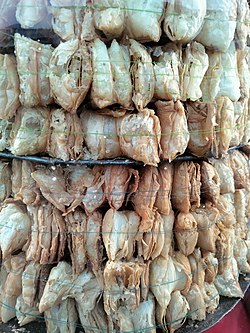Silao Nalanda
Silao | |
|---|---|
city of sweets | |
 | |
| Coordinates: 25°04′52″N 85°25′41″E / 25.081°N 85.428°E | |
| Country | |
| State | Bihar |
| District | Nalanda |
| Elevation | 60 m (200 ft) |
| Population (2011) | |
| • Total | 25,618 |
| Languages | |
| • Official | Magadhi, Hindi |
| Time zone | UTC+5:30 (IST) |
| ISO 3166 code | IN-BR |
Silao is a city and a notified area in Nalanda district in the Indian state of Bihar. It is known for the excellent Khaja made by its Halwais. It is also the headquarters of a Block, a small administrative unit, by the same name.
Geography[edit]
Silao is located at 25°04′52″N 85°25′41″E / 25.081°N 85.428°E. It has an average elevation of 60 metres (196 feet).
Demographics[edit]
As of 2001[update] India census,[1] Silao had a population of 20,177. Males constitute 52% of the population and females 48%. Silao has an average literacy rate of 52%, lower than the national average of 59.5%: male literacy is 60%, and female literacy is 43%. In Silao, 19% of the population is under 6 years of ag
Economy[edit]
Banks
- Allahabad Bank
- Madhya Bihar Gramin Bank
- State Bank of India
- Punjab National Bank
- Sub Post Office
- Kisan market, silao
- Union Bank of India
References[edit]
- ^ "Census of India 2001: Data from the 2001 Census, including cities, villages and towns (Provisional)". Census Commission of India. Archived from the original on 16 June 2004. Retrieved 1 November 2008.
See also[edit]

Well, that’s interesting to know that Psilotum nudum are known as whisk ferns. Psilotum nudum is the commoner species of the two. While the P. flaccidum is a rare species and is found in the tropical islands. Both the species are usually epiphytic in habit and grow upon tree ferns. These species may also be terrestrial and grow in humus or in the crevices of the rocks.
View the detailed Guide of Psilotum nudum: Detailed Study Of Psilotum Nudum (Whisk Fern), Classification, Anatomy, Reproduction